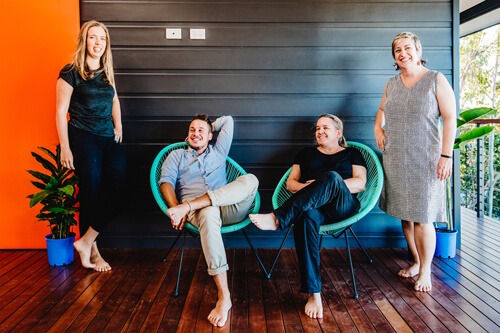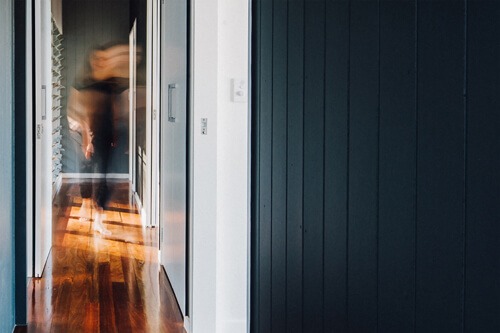Co-chair of EmAGN QLD Genevieve Vella recently caught up with Belinda Allwood to talk all things architecture.
GV: You mention that ‘hardship is fertile ground for opportunity’, can you tell us about some of the opportunity that has occurred in during the previous downturns you have lived through?
BA: Through times of economic hardship, I have learned to cross-train, in good times as well as bad, to build resilience and adaptability. I also learned to continually look for niche opportunities. Here are some of my experiences and learnings during the past two economic downturns.

DOWNTURN 1 – The Recession
I graduated from my bachelor’s degree at QUT into ‘the recession Australia had to have’ (Keating, 1990). It was a planned gap year to gain work experience between degrees and I couldn’t have timed it worse. It took me a year of job applications and cold calling despite having a year of prior experience working in two Brisbane architectural perspective studios. I finally secured a position in an architecture and landscape practice and worked there for around two years. I gained valuable experience, but I recall how little my degree had prepared me for working in practice. The pay was desperately low, and I was discouraged from continuing a career in architecture so did not resume my study. Instead I moved to far north Queensland and obtained a building designer licence. I drew on my previous experience and filled a niche producing architectural perspectives for several Cairns architecture practices. I also lived on a large rural cattle property where I learned to handle livestock, shoot, weld, drive heavy machinery and fix all manner of broken things. I became more resilient.
After a few years I sought the opportunity to learn new skills and changed careers entirely. I started working in the automotive industry, performing a couple of roles: aftermarket, and finance and insurance. This work was not very inspiring but paid well and it pushed me outside my comfort zone. I had to overcome my natural introversion to excel in the intensely competitive, numbers driven environment. I learned a lot about business, finance, marketing, and human behaviour. I also earned enough to buy land and build my first home. It was period of personal growth.
I also worked as a set technician during a film shoot and later at a staging company for six months. This work felt like I had run away to join the circus. It was fantastic. I spent my days welding, fibre-glassing, wood working and spray painting all manner of things at large scale. A workshop injury unfortunately put an end to this job, but I had found joy in creativity again. I honed my skills as a maker of things, gaining practical knowledge of materials and fabrication. Getting out of architecture allowed me to learn important skills for running a business and making things. All these early career ‘cross-training’ skills have been invaluable in setting up and running POD (People Oriented Design).
DOWNTURN 2 – The Global Financial Crisis (GFC)
I returned to architecture full time in 2004, working for a few Cairns firms as a technician, mostly on education projects. When the GFC hit in 2008, far north Queensland suffered a double whammy with cyclone Larry striking (cat 5). I kept working thanks to cyclone reconstruction and the Rudd government’s Building Education Revolution (BER) financial stimulus package. BER school projects kept many Cairns practices open over the ensuing 4-5 years. I was grateful I had so much prior experience on education projects. Job stability looked good, so instead of returning to university to do a master’s degree, I undertook the AACA national program of assessment in 2009. I passed, then registered as an architect the following year. By the time the stimulus package wound down, I was registered. It was a circuitous journey to registration that spanned two decades and much adversity. It felt like a great achievement.
During this period (2004-2013) I had observed the lack of succession planning and the lack of career progression in many practices. Practices in Cairns to that point had been mostly ‘old school’ patriarchal models of practice, with a couple of exceptions. I knew many female colleagues who were highly skilled and experienced, but with limited opportunity to advance. When I became registered, one of the practice directors stated that my registration meant nothing to him. This careless comment crystalised what working as a female architecture employee in Cairns still meant in 2010. Soon after, a colleague at the same practice was not supported when she became pregnant with her first child. This inequity strengthened my resolve. I knew one day I would start my own practice and it would be different. Cyclone Yasi (cat 5) hit far north Queensland in 2011, and that is when I met Dr Shaneen Fantin. We both signed up to Emergency Architects Australia to assist with cyclone reconstruction. We really enjoyed working together and recognised our skillsets were different but complimentary, and we knew that we were both independent, strong-willed, and ambitious.
During the GFC period I found opportunity in adversity, applied effort with strategic focus, and charted a course to independence and beyond. In 2014 Shaneen and I formed a partnership with a vision that would shape a practice different to any other in Cairns: one that would champion equity and diversity. Coincidentally, during this period many other female colleagues in Cairns took the opportunity to strike out and start their own sole-director practices also. Women turned the tables on adversity in the GFC and shifted the face of architectural practice in Cairns.
My experiences in these two economic downturns highlighted the value of cross-training to build resilience and adaptability. POD has experienced continual growth since 2014, yet we knew another economic downturn could come at any time. In 2017-18 POD was busy, but I made the time to undertake a Master of Landscape Architecture degree to further broaden my skillset. Doing this enabled our business to expand services, and this has helped us to maintain business growth during the 2020 pandemic.

GV: What are some of the skill sets that architects have that you think are easily transferable to other disciplines?
BA: Problem solving, negotiation, simultaneous detail, and big picture thinking.
GV: What do you think the role of the architect will be in the future? As the role seems to be ever evolving…
BA: In the past, architects have traditionally been service providers to clients or patrons. The role of the architect has changed a lot, particularly over the past decade. It has faced erosion by other less qualified construction industry participants and procurement processes. We see the results of this where profit and speed has taken precedence over other outcomes, and the value (tangible and intangible) of the project is adversely impacted. Now is the time for the architecture profession to stand up and show we are not only relevant: with our qualifications, knowledge, and expertise we are indispensable. We need to lead, educate, advocate, and innovate. Importantly, we need to ensure we have a seat at the big table wherever policy is shaped.
GV: What do you think the most important skill is to be a ‘successful’ architect?
BA: Architects need to be proficient in many areas to be successful because architecture is complicated. In addition to the many fundamental proficiencies, architects need to be clear and effective communicators. This means writing, listening, and talking. It also means communicating in clear English, not architectural jargon. People need to understand what you say, not be bamboozled by it.
GV: What do you think being a successful architect entails?
BA: There are many types of successful architect. Sadly, the profession has traditionally focussed on recognising those with a repertoire of beautiful built projects. This is slowly changing. There are many architects who are successful teachers, academics, and authors. Others provide important leadership in government roles. Some architects become leaders in marketing and communication, others become successful developers. I think the common defining factor of success is all these different types of architect have recognised their own superpower and excelled at it. They have all worked hard to be leaders in their specific field, and they are all equally important in defining the future of the profession. I particularly admire architects who work on projects that make a big difference for people of limited means, or who live in adversity. Often these projects have limited budgets but when done well they deliver immeasurable value for all.
GV: What are some of the defining features of a CV that makes them stand out?
BA: Firstly, a good CV needs to be clear and well written. Good structure, grammar and spelling are fundamental for a candidate to get to the interview stage. A good candidate will demonstrate their ability through achievements and experience, whether in architecture or another field. It is equally important to demonstrate motivation, fortitude and values through experiences and involvement in other pursuits. Architecture is more than a job. Cross-training in allied or complimentary areas can be of immense value. Some examples of this that we have seen at POD:
- A third-year architecture graduate who undertook a diploma in horticulture when he left school and worked as a landscaper throughout his architecture undergrad course
- A graduate who worked as a humanitarian volunteer in a third world country when she left high school
- A graduate proficient in a second language, working as an interpreter in the judicial system.
Sheer willingness, charm and persistence can also work wonders. A few years ago, we gave a Belgian backpacking architecture graduate his first architecture job. It followed his third unannounced, friendly, and enthusiastic drop by to our practice. We really needed help moving office at the time, and he was willing to turn his hand to anything, including shifting furniture and swinging a paint brush. In appreciation, we kept him on for several months and gave him some invaluable work experience. He is now employed in a practice back home in Belgium.
Some advice for students and graduates of architecture finding it tough during the pandemic: know that you are already strong and resilient because you have studied architecture. Reach out if you are struggling. Understand that you are not alone, and that everyone needs a hand at some point. Things WILL get better. Understand your strengths and weaknesses and work on both. Work towards becoming an expert in your area of strength and work on your weaknesses so they don’t hold you back. Cross-train. It is ok to step out of architecture to develop other skills. Also, become the best human you can be. Understand the adversity and perspective of others. Participate, contribute, and never stop learning.
